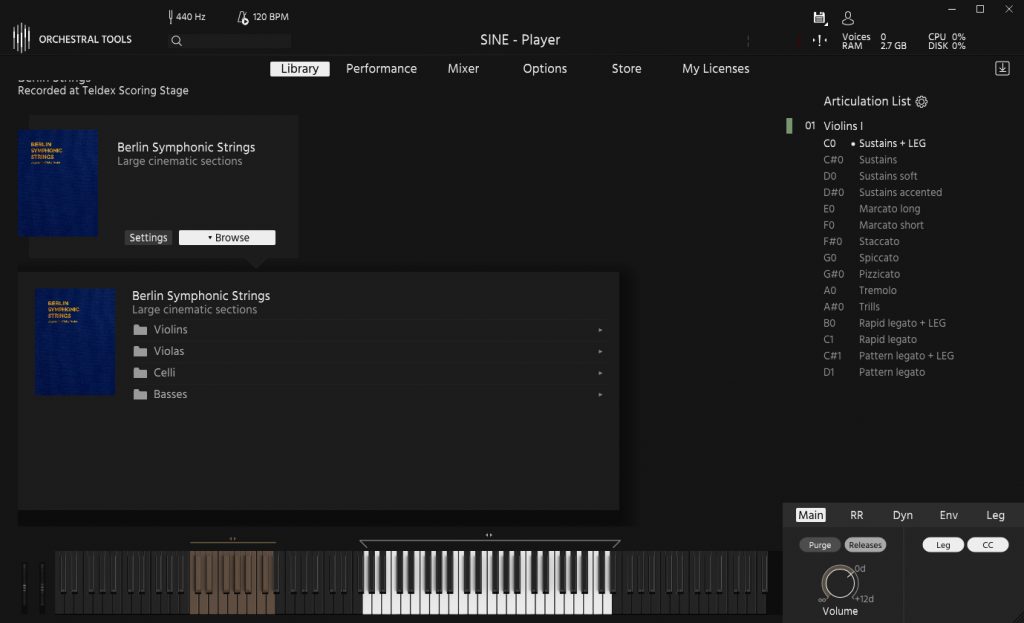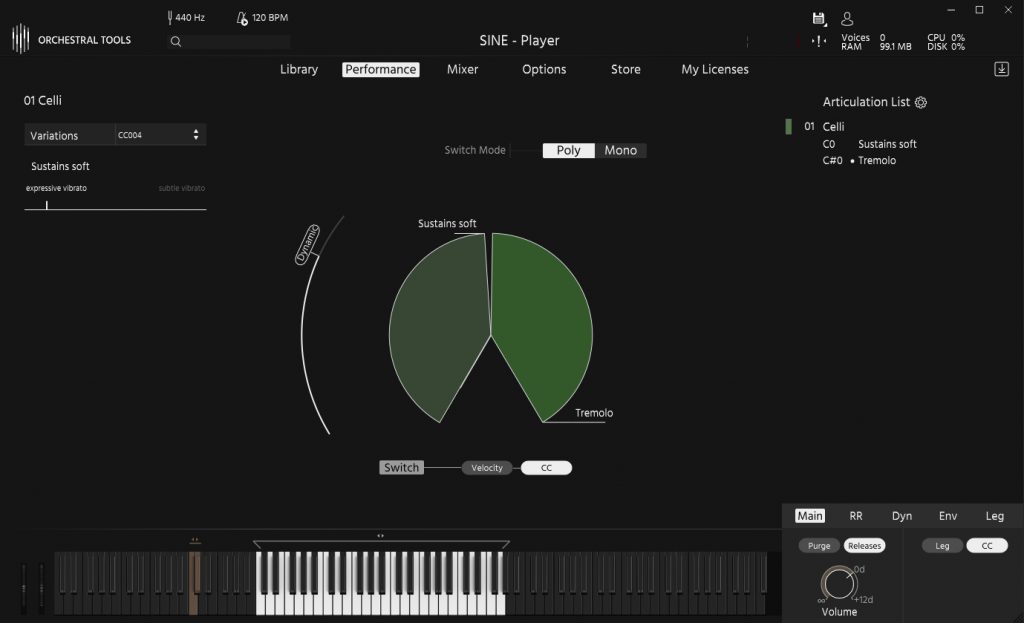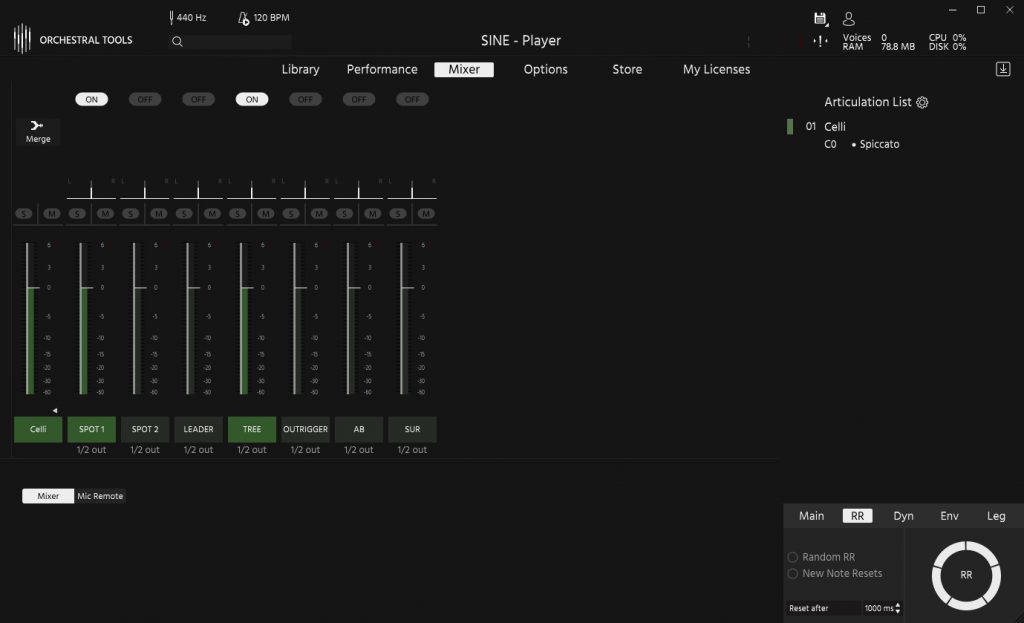INTRO
Today we will be checking Berlin Symphonic Strings, a new addition to Orchestral Tools’ acclaimed Berlin product line. Until now, Orchestral Tools’ flagship string library was Berlin Strings, which features deep-sampled mid-sized sections and an impressive number of articulations, with several expansions. Released in December 2020, Berlin Symphonic Strings is meant to fill a gap for larger ensembles in Orchestral Tools’ catalog, offering composers around the world full symphonic sections recorded at Teldex Scoring Stage.
So, in a period filled with numerous string library releases, does Berlin Symphonic Strings live up to the standard set by its predecessor? And is it a relevant library in 2021? We were kindly provided with a review copy to find out.
OVERVIEW
Berlin Symphonic Strings features full symphonic string sections of 18 first violins, 16 second violins, 14 violas, 12 celli, and 8 double basses. All the sections have been recorded in situ, in 4 dynamics levels. The library features an impressive collection of 7 microphone positions. This already marks the first difference to the original Berlin Strings, which features smaller, more focused sections (8/6/5/5/4) and just 4 microphone positions. The total file size of the sample library is 74.4 GB presented in OT’s own compressed SINEarc format.
The proclaimed goal of this new library is to offer wide cinematic, larger-than-life string recordings, and to open up possibilities in terms of playability, most notably with the introduction of 3 types of legatos. Here is a quick overview of the patches included:
- 3 types of Sustains (Soft, Immediate, and Accented)
- 2 types of Marcatos (Long and Short)
- Staccatos
- Spiccatos
- Pizzicatos
- Tremolos
- Trills
- 3 types of Legatos (Melodic, Rapid, and Pattern)
SINE PLAYER
Berlin Symphonic Strings exclusively runs in the SINE player. As with their previous SINE releases, this gives Orchestral Tools the ability to offer individual instruments of a product separately. This is a huge advantage for composers who want to stagger their purchases over time, or just simply are missing one particular instrument of a string section.
For this review, we used the most recent version of SINE v1.0.5 which is required in order to run Berlin Symphonic Strings. The new version also features important fixes over the previous versions. All the usual features and controls of SINE are, of course, present in Berlin Symphonic Strings: the possibility to activate legato for any articulation; precise control over round robins; easy ADSR settings and a new function, the so-called legato speed zones. These legato speed zones provide composers with a choice of different types of legatos depending on the speed at which they play. This choice is particularly useful for transitioning from sweeping melodic lines into agile figures like a run for example.

Another really nice feature is that users can disable dynamic layers for any articulation, something which was already present in Orchestral Tools’ Capsule. On top of using less RAM, if we know that our track will, for example, only need a pp to mp sustain in the intro, disabling the other 2 louder layers will give us more precise dynamic control. The whole CC1 range will then only be divided over these 2 layers instead of the default 4.
The installation itself is easy and consists of activating the purchase, navigating to the ‘My Licenses’ tab, and downloading the desired instrument sections and microphone positions à la carte. This process leaves the users in control of how much hard drive space they want to dedicate to the library.
ARTICULATIONS
As seen above, the library comprises 12 main articulations, across all sections except for the double basses, which do not come with Trills and feature the melodic legato only. Those 12 articulations are recorded in 3-to-4 dynamic layers. The Trills and Pizzicati are recorded over 3 dynamic layers (pp, mf, ff), along with the Basses’ tremolos. All of the other articulations feature an extensive selection of 4 dynamic layers (pp, mp, f, ff). This provides the library with a lot of dynamic versatility.
Going through the articulations, Orchestral Tools gives composers a lot of flexibility and decided to include 3 types of sustained attacks. The soft sustain, combined with the lower dynamics, is one of my favorites, giving the strings a sense of delicacy and emotional vulnerability. It fits superbly with choral and minimalist works. The immediate attack sustain is useful for punctuating musical phrases with distinct downstrokes. As for the accented sustain, it is well-suited for adventurous and heroic statements, reminiscent of what we could find in Metropolis Ark 4, albeit with far greater section sizes.
Adding to the versatility of the library, these sustains were also recorded with both subtle and expressive vibrato. In practice, the subtle vibrato is almost a non-vib recording, which can be particularly useful for textures. The expressive vibrato is more romantic in its approach, although not being completely molto-vibrato neither. This is always a matter of taste, but I personally prefer this design choice, especially for larger string sections, as being stuck with a heavy-vibrato recording only is far more limiting. Composers wanting an extra sense of vibrato could always layer another library, Berlin Strings being the obvious candidate, as it includes a pronounced strong vibrato, also recorded at the renowned Teldex stage.
One of the key selling points of Berlin Symphonic Strings is the presence of 3 legato types. The library allows users to combine any legato type with any patch. First, we find the traditional Melodic Legato. This one is well-suited for leading statements and melodies, especially since the library has a beautiful tone that is very apparent in its long articulations. In our tests, we got the impression that the legato transitions for the Violas and Celli were slightly more pronounced than the Violin sections.
Orchestral Tools also wanted to tackle a longstanding issue exclusive to the sampling world, something that is usually very trivial in real orchestral recordings: creating convincing ostinato lines. To this end, the Pattern Legato, comprised of 3 round robins, is their answer to craft these intricate inner motifs.
The multiple round-robin approach is indeed very effective to avoid the so-called “machine gun” effect. Composers also have the choice of activating the “random RR” option in SINE, to make the transition repetition even more arbitrary. In practice, the Pattern Legato transitions themselves tend to be shorter than the melodic ones, as one would expect, but also a bit more defined. While we might want these inner ostinato lines to be up-front sometimes, in many tracks they are used as unobtrusive texture devices. For this use case, we found that lowering the legato volume by a 1 or 2 dB was a better fit than letting SINE automatically scale it. Again, a good proof of the enhanced flexibility SINE offers.
Finally, and in the same logic, Orchestral Tools wanted to offer a solution to craft rapid motifs, and included a Rapid Legato. When used in combination with sustains, this legato is useful for agile statements in melodies, creating a blurred type of transition. When used with the rapid legato patch, which is partly based on spiccatos, they can be used effectively for runs.

Trills and tremolos are also included and feature expression options comparable to the sustains. As of note, SINE allows you to morph 2 articulations together, by using its poly-switching function. When using dynamics, it is then possible to gradually morph from a sustain to a tremolo for example. The amount and variety of short articulations are refreshing and constitute another huge strength of this library. There is an excellent consistency in the programming and editing of the samples, and with 4 dynamic layers, they allow for varied, expressive phrasing, and fast workflow. A great selection throughout!
All in all, these main articulations should cover most needs. Our only regret was the absence of Harmonics, which are often put to good use for pedal notes and atmosphere beds, and are quite commonly used in string writing.
MICROPHONE MIXES
Berlin Symphonic Strings features 7 microphone positions. Besides the usual selection, which makes the library easily compatible with its predecessors, Orchestral Tools notably added Leader and Outrigger microphone mixes. The former adds focus, particularly useful for such large sections, and the latter adds a sense of width. All in all, the selection of microphones represents a good compromise between usefulness and hard drive occupancy.

And as with all Orchestral Tools’ releases, I am personally fond of adding a bit of AB mic to the mix, giving an added sense of spatialization. In fact, I ended up favoring a balanced mix comprised of Spot, Leader, Tree, AB, and Outriggers, gain staged to taste. Of course, activating all these microphones would occupy a few GB of memory, but using the SINE mic merge function will cut that down significantly (in version 1.0.5 this function is non-working, however, the upcoming v1.0.6 will have it restored).
THE SOUND OF BERLIN SYMPHONIC STRINGS
The tone of Berlin Symphonic Strings is probably one of its major strengths, it is truly beautiful. The library has a vivid, bright sound signature. Given the size of the sections, we were pleasantly surprised that the recordings were so clear, and almost silky in nature.
When layering with other string libraries, the library was instantly able to add a sense of brilliance to the mix, on top of its inherent width. Composers familiar with the sound of the Teldex scoring stage will definitely recognize the quality of the room, having a reasonable tail length. As it is, the library is perfectly usable in a cinematic context without the need of using any additional reverb. Our tests, which involved an algorithmic reverb (VSS3), Seventh Heaven Professional, and Cinematic Rooms led to very satisfying results, too.
WISHLIST
Now, is there anything we wish Orchestral Tools would improve or add to what is already a great library? This is, of course, very subjective, but I think there are a few things that come to mind:
The first one I can come up with is the benefit of adding a portamento option to control legato slurs. Also, by going through the articulation list, one might have noticed that the library doesn’t include any Harmonics or extended playing techniques like Sul Pont or Sul Tasto. We can only speculate that Orchestral Tools decided to release a more focused, significantly cheaper main library, and might add more content in the form of expansions later, similar to what they did for their previous Berlin Strings.
That would open up exciting possibilities given the experience they have acquired now. Will they adapt some concepts from their recent textural products to a symphonic string section? Given how textural work has grown in importance these past few years and has become (maybe more than ever before?) an essential part of media composing, this could be a possibility as well.
Finally, and this is more of a widespread problem in the sampling world, given the number of options the library offers, I wish Orchestral Tools would have included at least a short manual. Concepts such as legatos types, the ability to combine any type of legato with any patch, even those already named after a particular type of legato, would benefit from a short written explanation. Nothing that a few isolated tests cannot decipher though.
CONCLUSION
Orchestral Tools delivers here a premium quality string library that contains beautiful recordings. With its vivid tone, its flexibility, and its excellent short articulations, Berlin Symphonic Strings represents a great new entry in the company’s catalog.
Capable of rendering from the most emotional phrases to the most powerful musical statements, its versatility is a great asset. It also makes for a great companion to the modern sound of Junkie XL Brass.
Priced competitively, Berlin Symphonic Strings is a great option to consider for composers in the market for a large cinematic and vivid-sounding library. The fact that its instruments are available to buy as separate sections represent another huge advantage in terms of purchasing options.
We are certainly looking forward as to how Orchestral Tools will expand on Berlin Symphonic Strings in the future.
Pros
- Beautiful vivid tone
- Amazing flexibility with different legatos and SINE playability options
- Consistent, powerful short articulations
Cons
- No Harmonics or extended techniques
- No portamento
- No manual
RECOMMENDED: 8/10
Berlin Symphonic Strings is available as a download from Orchestral Tools’ online store or directly from within your SINE Player plugin. At the moment, Berlin Symphonic Strings is offered for €549 with individual instruments available from €105 each.


0 comments on “Orchestral Tools – Berlin Symphonic Strings (Review)”